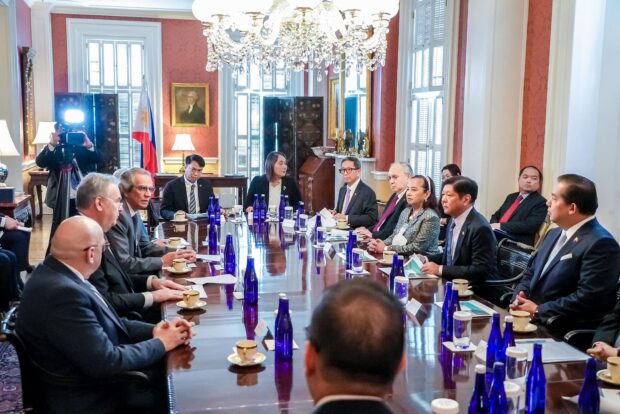US firm plans to build small nuclear power plants in PH

POWER DEAL President Marcos and his delegation meet with the top executives of NuScale Power Corp. in Washington on the sidelines of his working visit to the United States on Monday. They discussed potential cooperation on energy. —MALACAÑANG PHOTO
WASHINGTON — NuScale Power Corp., a publicly traded American company that designs and markets small modular reactors (SMRs), on Monday (early Tuesday in Manila) disclosed plans to build SMRs worth up to $7.5 billion in the Philippines.
Top officials of NuScale Power relayed their intention in a meeting with President Ferdinand Marcos Jr. moments before he went to see US President Joe Biden at the White House.
Marcos, who is in the US capital for a five-day working visit, said NuScale’s SMR project would be critical in addressing the country’s energy shortage, which has caused hourslong outages in several provinces.
“We need everything (to address the energy problem)… and this new technology is something,” Marcos said.
Last September, Marcos met with executives of NuScale Power during his official visit to the United States.
Article continues after this advertisementPresidential Communications Secretary Cheloy Garafil said the project was an unsolicited proposal of NuScale and its local partner, Prime Infrastructure Capital Inc. of tycoon Enrique Razon Jr., who is among the business leaders accompanying the president in his first official trip to Washington.
Article continues after this advertisement“[There are] no specific areas yet. But they are looking at Luzon,” Garafil told the Inquirer.
The Oregon-based NuScale Power said it would soon be conducting a study to identify the possible sites for its SMRs in the Philippines.
Clayton Scott, NuScale executive vice president for business, assured the Philippine delegation that their company has “very high confidence that our technology will perform as expected.”
Scott said their technology was a product of research conducted by nuclear scientists and the “first and only one of its kind” that has secured the approval of the US Nuclear Regulatory Commission, which approved last January the design for the country’s first small reactor, a 50-megawatt (MW) advanced light-water SMR developed by NuScale Power.
SMRs are a fraction of the size and cost of a conventional nuclear power reactor and can produce low-carbon electricity at about a third of the generating capacity of traditional nuclear facilities, according to the International Atomic Energy Agency (IAEA).
Given its modular nature, SMRs can be factory-assembled and transported as a unit to a location, for installation into an existing grid or remotely off-grid, making it ideal for isolated areas with limited grid capacity.
The world’s first advanced SMR is located just off Russia’s Arctic coast and began commercial operation in May 2020.
Other SMRs are under construction or in the licensing stage in Argentina, Canada, China, Russia, South Korea, and the United States, according to the IAEA.
Advocacy
President Marcos has been strongly advocating the inclusion of nuclear power in the Philippines’ energy mix.
In his first State of the Nation Address in July last year, Marcos said the time was ripe to examine the country’s policies toward nuclear energy, noting that with modern technology, safeguards have been placed against possible accidents.
He said that should the Philippines decide to use nuclear energy, the government would follow the guidelines set by the IAEA, which prescribes a country seeking to embark on a nuclear energy program to first resolve as many as 19 infrastructure issues.
Even during the presidential campaign, Marcos already expressed that he wanted the government to revisit the possible revival of the Bataan Nuclear Power Plant (BNPP), built during the presidency of his late father and namesake.
The 620-MW power plant in Morong, Bataan, was built for nine years beginning in 1975 at a cost of $2.3 billion, bloated from the initial estimated cost of only $600 million, allegedly due to payoffs to some government officials.
But the BNPP was never fueled because of public fears caused by the Chernobyl nuclear accident in 1986 and charges of corruption.
In November last year, Marcos said he wanted to develop nuclear energy in the Philippines in partnership with France as the European nation has extensive experience in nuclear power production.
Marcos made the remarks after his meeting with French President Emmanuel Macron on the sidelines of the Asia-Pacific Economic Cooperation Summit in Bangkok, Thailand.
Opposition
During her visit to the Philippines in the same month, US Vice President Kamala Harris said Manila and Washington were in negotiations on possible nuclear energy cooperation.
In Manila, nuclear-free advocates questioned NuScale Power’s plan, saying SMR technology has not been tested enough or scalable in ways that are useful to Filipinos.
In separate interviews, the Nuclear and Coal-Free Bataan Movement (NCFBM) and Greenpeace Philippines said SMR technology was not only risky but also even more difficult to maintain than conventional nuclear power plants.
SMRs have yet to be commercialized worldwide, said NCFBM coordinator Veronica Cabe. Even now, only two countries have it — China and Russia — and they operate more as prototypes.
Citing a Stanford University and University of British Columbia study, Greenpeace campaigner Khevin Yu said SMRs generate more radioactive waste than conventional nuclear power plants.
“It might be a little too difficult to implement this because there are no existing examples operating these,” Cabe said. “So the question is: are they just going to use us as guinea pigs? What will be our role here?”
Moreover, the pledge also goes against the global trend of superpowers like Germany exiting nuclear power, they said.